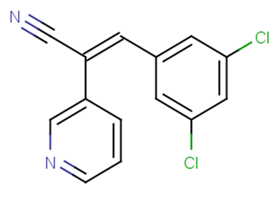
RG 14620
CAS No. 136831-49-7
RG 14620( RG 14620 | TYRPHOSTIN RG 14620. )
Catalog No. M17976 CAS No. 136831-49-7
RG14620 is an epidermal growth factor receptor (EGFR) inhibitor.
Purity : >98% (HPLC)
 COA
COA
 Datasheet
Datasheet
 HNMR
HNMR
 HPLC
HPLC
 MSDS
MSDS
 Handing Instructions
Handing Instructions
| Size | Price / USD | Stock | Quantity |
| 2MG | 27 | In Stock |


|
| 5MG | 43 | In Stock |


|
| 10MG | 63 | In Stock |


|
| 25MG | 125 | In Stock |


|
| 50MG | 245 | In Stock |


|
| 100MG | 410 | In Stock |


|
| 500MG | 888 | In Stock |


|
| 1G | Get Quote | In Stock |


|
Biological Information
-
Product NameRG 14620
-
NoteResearch use only, not for human use.
-
Brief DescriptionRG14620 is an epidermal growth factor receptor (EGFR) inhibitor.
-
DescriptionRG-14620 is an EGFR inhibitor. It is a non-phenolic tyrphostin analog, which is selective for the EGF receptor and long acting. It inhibits EGF-stimulated HER14 cell proliferation (IC50=3 μM) as well as tumor growth in vivo.
-
In VitroRG14620 inhibits colony formation (IC50=3 μM) and DNA synthesis (IC50=1 μM) by HER 14 cells, which are stimulated by 50 ng/mL EGF, in a dose-dependent manner. RG14620 also suppresses colony formation(IC50=4 μM) and DNA synthesis (IC50=1.25 μM) by EGF-stimulated MH-85 cells in a dose-dependent manner. The growth-inhibitory effect of RG14620 irreversible.
-
In VivoRG14620, at a dose of 200 g/mouse/day inhibits H-85 tumor growth in nude mice. Mice show less cachexia and hypercalcemia, eat more food, and are more active than untreated MH-85 tumor-bearing animals.
-
SynonymsRG 14620 | TYRPHOSTIN RG 14620.
-
PathwayOthers
-
TargetOther Targets
-
RecptorHER14 colony formation| HER14 DNA synthesis
-
Research AreaCancer
-
Indication——
Chemical Information
-
CAS Number136831-49-7
-
Formula Weight275.13
-
Molecular FormulaC14H8Cl2N2
-
Purity>98% (HPLC)
-
SolubilityDMSO : ≥ 26 mg/mL; 94.50 mM
-
SMILESc1cc(cnc1)/C(=C\c1cc(cc(c1)Cl)Cl)/C#N
-
Chemical Name(E)-3-(3,5-dichlorophenyl)-2-(pyridin-3-yl)acrylonitrile
Shipping & Storage Information
-
Storage(-20℃)
-
ShippingWith Ice Pack
-
Stability≥ 2 years
Reference
1. Yoneda T,et al. Cancer Res. 1991 Aug 15;51(16):4430-5.
molnova catalog



related products
-
Urelumab
Urelumab(BMS-66513) is a humanized IgG4 monoclonal antibody, often used as a CD137 agonist.
-
3-O-[5-O-feruloyl-be...
3-O-[5'''-O-feruloyl-beta-D-apiofuranosyl(1'''->2'')-beta-D-glucopyranosyl] rhamnocitrin is a natural product for research related to life sciences.
-
Prolactin Releasing ...
Prolactin Releasing Peptide (1-31), bovine



 Cart
Cart
 sales@molnova.com
sales@molnova.com


